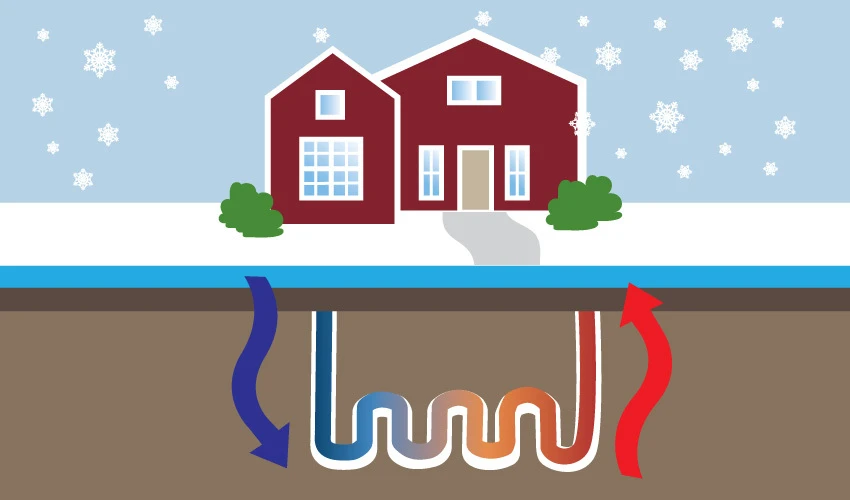
The notion of geothermal heat may conjure visions of volcanic hot springs. While it seems like something that only exists in remote Nordic landscapes, geothermal heating is actually a viable, efficient, low-emissions heat source for homes worldwide – and one that is growing in popularity.
But what is geothermal and how does geothermal heating work? Learn the answers to these questions and more from the heating pros at Aire Serv!
What Is Geothermal Heating
Geothermal heating works by harnessing the heat energy just feet below the earth’s surface and converting it into warm air through the use of geothermal heat pumps (GHPs). Also known as GeoExchange, earth-coupled, ground, or water-source heat pumps, they are driven by a small amount of electricity (never natural gas) and are by far the most efficient way to heat and cool a home.
That’s right, geothermal heat pumps not only replace your expensive, inefficient, polluting gas furnace, they also serve as your air conditioner—and some can also drive your hot water heater at practically no additional cost.
Is Geothermal Heating Too Good To Be True? No!
Further, a common misconception about geothermal heating is that it is only available in specific geographical locations. While regions close to volcanic activity (often found along tectonic plate boundaries) have a higher output of geothermal energy and are often host to utility-scale geothermal electric power plants, homes anywhere can take advantage of residential geothermal technology to heat and cool their home at low cost with very few emissions.
How Does Geothermal Heating Work
So how exactly does geothermal heating function? The earth’s surface absorbs about 50 percent of the sun’s energy into the ground. This, and the radioactive decay of minerals, produces geothermal energy. Residential geothermal heating works by burying pipes filled with liquid several feet below the surface. This is done in your yard or, in many cases, under your driveway. The liquid in the pipes/tubes absorb this trapped heat energy and transfers it to the geothermal heat pump in your basement. The GHP removes the heat from the liquid and passes it on to the dwelling the same way a furnace does, through the forced-air ductwork.
Because they don’t burn fossil fuels and require very little electricity to operate, geothermal heat systems are up to four times more efficient than traditional furnaces.
Geothermal Heating Systems
Geothermal heating systems can be set up in a variety of formats. Here are a few ways in which geothermal heating can be configured:
Closed-Loop System
This format consists of continuous underground pipes filled with a liquid solution that transfers geothermal energy to the heat pump. This system can be set up in a vertical or horizontal arrangement.
- Vertical
This is the most common form of a geothermal heat system, as it requires less outdoor space. Holes are drilled often by a well driller and the continuous piping loops are then installed vertically.
- Horizontal
In this model, the continuous piping for the closed-loop system is laid out in the yard in a horizontal configuration. This has potential to reduce frontend costs, as it can be installed with a backhoe rather than a drilling rig.
Open-Loop System
This geothermal system uses groundwater for its heat source. Rather than a liquid circulated in closed pipes to deliver heat to the pump, an open-loop pumps groundwater directly to the heat pump to transfer the geothermal energy.
Pond/Lake Hybrid System
A form of an open-loop system, the pond/lake hybrid relies on an ample pond or lake to provide the geothermal energy. This pond or lake water is connected to the heat pump.
How Can Geothermal Heating Work for You
Despite the higher upfront costs associated with installing new geothermal heating systems or retrofitting older homes, geothermal heating may be right for you! Long term, these systems have proven to be worth the investment through energy cost savings, emissions cuts, and even higher property resale values. Further, geothermal systems can often be integrated with other home systems to cool the air or heat water for fixtures, creating further efficiencies.
Remember, the notion that only certain niche regions are sufficient for geothermal heating is largely misguided. Ready to learn more about geothermal heating options for your home? Request an appointment online or call us to speak with a local Aire Serv® service professional.

